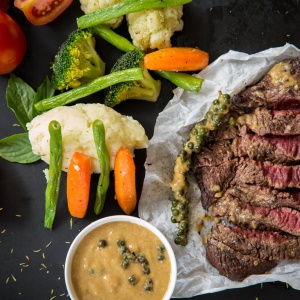
FCRN member Sander Biesbroek of Wageningen University & Research has co-authored this paper, which is the first modelling study to include and monetise social costs and benefits of a 15% or 30% meat tax or a 10% fruit and vegetables subsidy in the Netherlands. It finds that all three interventions could lead to a net benefit to society over a 30 year time frame.
The study looks at how the taxes or subsidies would affect consumption of the relevant foodstuffs, and the likely impact on health (colorectal cancer, coronary heart disease, type 2 diabetes, lung cancer and stroke) and the environment (greenhouse gas emissions, acidification, freshwater eutrophication, saltwater eutrophication and land use).
The table below summarises the predicted impacts, quantified as euros within a social cost-benefit analysis framework. All three interventions lead to a net benefit to society. In the case of a fruit and vegetable subsidy, the intervention costs money and causes increased environmental damage because of higher consumption, but these costs are outweighed by benefits such as health and productivity (because of fewer people taking time off work because of health problems). In the case of a meat tax, the tax generates revenue for the state and also has environmental and health benefits because of lower meat consumption. The 30% meat tax produces greater net benefits than the 15% meat tax.
 Image: Based on Table 2 of Broeks et al. Total societal costs and benefits for all scenarios compared to reference over a 30-year period. Green indicates a benefit; red indicates a cost. Highlights added by the FCRN. QALY = Quality Adjusted Life Years. The social benefit of health outcomes depends on the monetary value assigned to one QALY (€50,000 or €100,000).
Image: Based on Table 2 of Broeks et al. Total societal costs and benefits for all scenarios compared to reference over a 30-year period. Green indicates a benefit; red indicates a cost. Highlights added by the FCRN. QALY = Quality Adjusted Life Years. The social benefit of health outcomes depends on the monetary value assigned to one QALY (€50,000 or €100,000).
The paper notes that the way people are affected by food taxes is likely to depend on their socio-economic status (SES). It speculates that since lower SES groups tend to eat lower levels of fruit and vegetables and more meat than higher SES groups, and since the food purchasing patterns of people in lower SES groups are particularly responsive to price, food price interventions could be “an effective approach to increase healthiness and environmental friendliness of diets”. It also suggested that combining both a meat tax and a fruit and vegetable subsidy could mitigate some of the losses that lower SES groups might experience from food price interventions. However, the model used in the paper did not classify costs and benefits according to SES, so the authors call for further research in this area.
Abstract
Background
Implementation of food taxes or subsidies may promote healthier and a more sustainable diet in a society. This study estimates the effects of a tax (15% or 30%) on meat and a subsidy (10%) on fruit and vegetables (F&V) consumption in the Netherlands using a social cost-benefit analysis with a 30-year time horizon.
Methods
Calculations with the representative Dutch National Food Consumption Survey (2012–2014) served as the reference. Price elasticities were applied to calculate changes in consumption and consumer surplus. Future food consumption and health effects were estimated using the DYNAMO-HIA model and environmental impacts were estimated using Life Cycle Analysis. The time horizon of all calculations is 30 year. All effects were monetised and discounted to 2018 euros.
Results
Over 30-years, a 15% or 30% meat tax or 10% F&V subsidy could result in reduced healthcare costs, increased quality of life, and higher productivity levels. Benefits to the environment of a meat tax are an estimated €3400 million or €6300 million in the 15% or 30% scenario respectively, whereas the increased F&V consumption could result in €100 million costs for the environment. While consumers benefit from a subsidy, a consumer surplus of €10,000 million, the tax scenarios demonstrate large experienced costs of respectively €21,000 and €41,000 million. Overall, a 15% or 30% price increase in meat could lead to a net benefit for society between €3100–7400 million or €4100–12,300 million over 30 years respectively. A 10% F&V subsidy could lead to a net benefit to society of €1800–3300 million. Sensitivity analyses did not change the main findings.
Conclusions
The studied meat taxes and F&V subsidy showed net total welfare benefits for the Dutch society over a 30-year time horizon.
Reference
Broeks, M. J., Biesbroek, S., Over, E. A. B., van Gils, P. F., Toxopeus, I., Beukers, M. H. and Temme, E. H. M. (2020). A social cost-benefit analysis of meat taxation and a fruit and vegetables subsidy for a healthy and sustainable food consumption in the Netherlands. BMC Public Health 20, 643.
Read the full paper here. See also the Foodsource resource What interventions could potentially shift our eating patterns in sustainable directions?












Post a new comment »